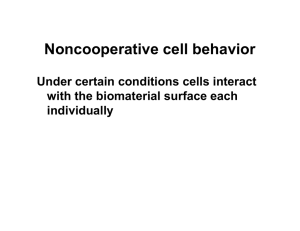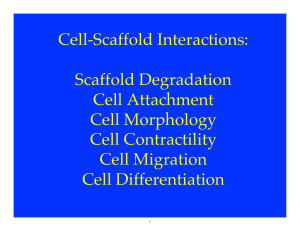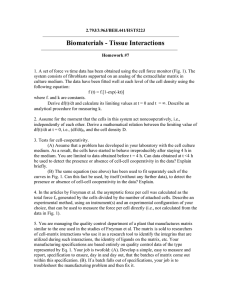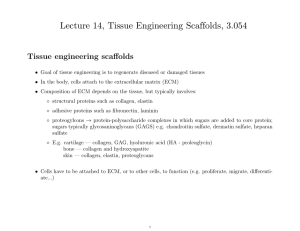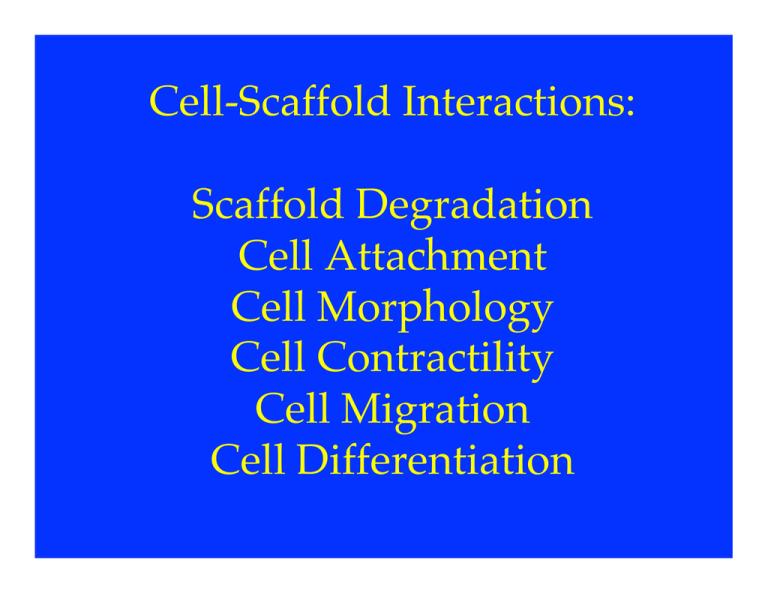
!
Cell-Scaffold Interactions:!
!
Scaffold Degradation!
Cell Attachment!
Cell Morphology!
Cell Contractility!
Cell Migration!
Cell Differentiation"
Cell Adhesion"
Gibson, L. J., M. Ashby, et al. Cellular Materials in Nature and Medicine. Cambridge University
Press. © 2010. Figure courtesy of Lorna Gibson and Cambridge University Press.
Figure removed due to copyright restrictions. See Figure 9.1: Gibson, L. J., M. Ashby,
et al. Cellular Materials in Nature and Medicine. Cambridge University Press, 2010.
http://books.google.com/books?id=AKxiS4AKpyEC&pg=PA255
Gibson, Ashby and Harley, 2010"
Cell Attachment"
SA 3.65 ⎛ ρ ⎞
=
⎜ ⎟
V
l ⎝ ρs ⎠
* 1/ 2
0.718
=
d
Open-cell tetrakaidecahedron
Circular cross-section edges
l = edge length
d = pore size
Collagen-GAG scaffold:
s = 0.005, d = 96, 110, 121,
150m
Cell Attachment"
Percent Cell Attachment
60
40
R2 = 0.95
20
2
R = 0.91
24 hrs post-seeding
48 hrs post-seeding
0
0.00400
0.00500
0.00600
0.00700
-1
Specific Surface Area, ?m-1
0.00800
O'Brien, B. A. Harley, I. V. Yannas, et al. Biomaterials 26 (2005): 433-41.
Courtesy of Elsevier. Used with permission.
http://www.sciencedirect.com/science/article/pii/S0142961204002017
O’Brien"
Mouse MC3T3 osteogenic cells
on collagen-GAG scaffold"
Cell Morphology"
PLGA scaffolds
Seeded with
rotator cuff
fibroblasts"
Random"
Aligned"
Moffat, K. L., et al. Clinics in Sports Medicine 28 (2009): 157-76.
Courtesy of Elsevier. Used with permission.
http://www.sciencedirect.com/science/article/pii/S0278591908000707
Moffat et al, 2009b"
"
Cell Morphology"
E=
11.6
"
67
"
147"
"497 Pa"
Dikovsky, D. H., et al. Biophysical Journal 94 (2008): 2914-25.
Courtesy of Elsevier. Used with permission.
http://www.sciencedirect.com/science/article/pii/S0006349508705411
Smooth muscle cells encapsulated "
in a PEG-fibrinogen hydrogels of varying modulus"
Dikovsky et al., 2008"
Cell Contractility:
!
Wound Contraction
and Scar Formation"!
Wound contraction associated
with scar formation
Image source unknown. All rights reserved. This content is excluded from our Creative
Commons license. For more information, see http://ocw.mit.edu/help/faq-fair-use/.
Use of collagen-GAG matrix
inhibits wound contraction and
scar formation; results in
synthesis of normal dermis
Photo courtesy of IV Yannas"
This observation has led to interest in contractile response of cells on
the scaffold
Contractility of Cells"
• Biological cells can contract a scaffold"
• Free-floating tests"
– Measure diameter change"
• Developed cell force monitor (CFM) to
measure forces"
Collagen-GAG Scaffold"
Pek et al., 2004
Fig. 1: Pek, Y. S., M. Spector, et al. Biomaterials 25 (2004): 473-82.
Courtesy of Elsevier. Used with permission.
http://www.sciencedirect.com/science/article/pii/S0142961203005416
Scaffold developed by IV Yannas (MIT)"
Cell Force Monitor
(CFM) !
Collagen-GAG!
Matrix!
Freyman"
Adjustable
Horizontal Stage
To Amplifier / PC
Be-Cu
Beam
Rotation
Stage
Matrix
Proximity
Sensor
Silicone
Well
Adjustable
Height
Post
Base Plate
Source: Freyman, T. M., et al. "Fibroblast Contractile Force is Independent of the Stiffness Which Resists the Contraction."
Experimental Cell Research 272 (2002): 153-62. Courtesy of Academic Press/Elsevier. Used with permission.
10
CFM: Effect of Cell Number
Force [mN]
Force
(mN)"
15
F = Fasymptote (1− e−t/τ )
10 Million Attached
Fibroblasts at 22h
10
7.2
6.0
4.4
5
2.3
0
0
6
12
18
-5
Time [Hours]
Freyman"
Time constant 5.7 hours
Freyman, T. M., I. V. Yannas, et al. "Fibroblast Contraction of a Collagen-GAG Matrix."
Biomaterials 22 (2001): 2883-91. Courtesy of Elsevier. Used with permission.
24
Effect of Cell Number"
Asymptotic
Force(mN)"
[mN]
Asymptotic
Force
15
Fa = 1.0·Nc + 1.2
R2 = 0.97
(2)
10
(3)
(3)
5
(4)
(n=4)
Force Per Cell ~ 1nN
0
0
4
8
Number of Attached Fibroblasts at 22 Hours [Millions]
Freyman, T. M., I. V. Yannas, et al. "Fibroblast Contraction of a Collagen-GAG Matrix."
Biomaterials 22 (2001): 2883-91. Courtesy of Elsevier. Used with permission.
Freyman"
12
Effect of System Stiffness"
Displacement perper
Cell Cell
[nm] (nm)"
Displacement
4.0
0.7 N/m
2.5
1.4 N/m
1.0
-0.5
Stiffness = 10 N/m
0
6
12
18
24
Time [Hours]
Freyman, T. M., et al. "Fibroblast Contractile Force is Independent of the Stiffness which Resists the Contraction."
Experimental Cell Research 272 (2002): 153-62. Courtesy of Elsevier. Used with permission.
Freyman"
Effect of System Stiffness"
Force
Force
perCell
Cell [nN]
per
(nN)"
4
3
Stiffness = 1.4 N/m
0.7 N/m
2
10 N/m
1
0
0
6
12
18
24
-1
Time [Hours]
Freyman, T. M., et al. "Fibroblast Contractile Force is Independent of the Stiffness which Resists the Contraction."
Experimental Cell Research 272 (2002): 153-62. Courtesy of Elsevier. Used with permission.
Freyman"
Methods: Cell Elongation!
Average aspect ratio of cells"
– Time points 0, 4, 8, 15, 22, and 48 h (n=3)"
– Hematoxylin & eosin (H&E) stained
glycomethacrylate (GMA) sections (5mm)"
– Digital image analysis (~200 cells per sample)!
Fibroblast Morphology!
Freyman"
Source: Freyman, T. M., et al. "Micromechanics of Fibroblast Contraction of a
Collagen–GAG Matrix." Experimental Cell Research 269 (2001): 140-53.
Courtesy of Academic Press/Elsevier. Used with permission.
16
Fibroblast Morphology
3.5
AR = ARasymptote (1− e−t/τ )
Aspect
Ratio
Aspect
Ratio"
3.0
2.5
2.0
Time constant ~ 5 hours
1.5
1.0
0
Freyman"
10
20
30
Time (h)
40
50
Image after Freyman, T. M., et al. "Micromechanics of Fibroblast Contraction of
a Collagen–GAG Matrix." Experimental Cell Research 269 (2001): 140-53.
60
Time Constants"
• Time constant for contraction ~ 5.7
hours"
• Time constant for elongation ~ 5 hours"
• Suggests a link between the average "
elongation of the cell population and
the macroscopic contraction of the
population"
Methods: Live Cell Imaging"
Infinity Corrected
Objective
Cover Slip
Thick Microscope
Slide with Well
Cell Seeded
Matrix
Heated Stage
Image after Freyman, T. M., et al. "Micromechanics of Fibroblast Contraction
of a Collagen–GAG Matrix." Experimental Cell Research 269 (2001): 140-53.
2m
Live Cell "
Imaging!
50 mm
42m
38m
33m
28m
26m
25m
23m
19m
Freyman"
3h
20
Live Cell
Imaging
Figure removed due to copyright restrictions. See Figure 7: Freyman, T. M., et al. "Micromechanics
of Fibroblast Contraction of a Collagen–GAG Matrix." Experimental Cell Research 269 (2001): 140-53.
Freyman"
Live Cell Imaging
"
Source: Freyman, T. M., et al. "Micromechanics of Fibroblast Contraction of a
Collagen–GAG Matrix." Experimental Cell Research 269 (2001): 140-53.
Courtesy of Academic Press/Elsevier. Used with permission.
Schematic
of cell
elongation
and
matrix
contraction
Freyman"
Source: Freyman, T. M., et al. "Micromechanics of Fibroblast Contraction of
a Collagen–GAG Matrix." Experimental Cell Research 269 (2001): 140-53.
Courtesy of Academic Press/Elsevier. Used with permission.
Discussion"
• Cell elongation linked to contraction"
– time constants for cell elongation and
contractile force development similar
( ~ 5h)"
– as cell elongates, observe gap between
central portion of cell and matrix"
– adhesion points at periphery of cell"
– tensile forces in actin filaments induce
compression in the matrix => buckling "
Single Cell Contractile Force"
• Contraction: cell buckling"
• Measure Es from AFM bending test"
• Allows calculation of contractile force of
single fibroblast"
Single Cell Contractile Force"
Es = 762 MPa"
(dry) "
"
"Es = 5.28 MPa"
"(wet)"
Source: Harley, B. A., et al. Acta Biomaterialia 3 (2007): 463-74.
Courtesy of Elsevier. Used with permission.
http://www.sciencedirect.com/science/article/pii/S1742706107000025
Harley, Silva"
Single Cell Contractile Force"
n π E sI
• Euler buckling:" F =
2
l
2
2
πd 4
I=
64
"n2 = 0.34 (hydrostatic loading of
tetrakaidecahedral cells (Triantafillou)"
""d = 3.9 +/- 0.8 m; l from live cell imaging
"
Harley, Wong"
Cell Migration"
Figure removed due to copyright restrictions. Figure
3: Cornwell, K. G., et al. Journal of Biomedical
Material Research A 80 (2007): 362-71.
http://onlinelibrary.wiley.com/doi/10.1002/jbm.
a.30893/abstract
Source: Lo, et al., Biophysical Journal 79 (2000): 144-52.
Migration speed on onedimensional fiber
constructs"
NIH 3T3 cells on 2D flat
substrate:"
Cells on soft substrate
cross to stiff substrate"
"
Cells on stiff substrate
will not cross onto soft
substrate; instead spread
out at boundary "
Courtesy of Elsevier. Used with permission.
http://www.sciencedirect.com/science/article/pii/S0006349500762795
Top: Cornwell et al., 2007; Bottom: Lo et al, 2000"
"
Cell Migration:!
Fibroblasts in CG Scaffold"
Courtesy of Brendan Harley. Used with permission.
Confocal "
Microscopy"
"
NR6 Fibroblasts"
CMFDA Live"
Cell Tracker"
"
CG Scaffold"
Alexa Fluor 633"
Stain"
Harley"
Fibroblast Migration: !
Spot Tracking"
Harley"
Courtesy of Brendan Harley. Used with permission.
Migration Speed !
vs Strut Stiffness"
Source: Harley, B. A. C., et al. Biophysical Journal 95 (2008): 4013-24.
Courtesy of Elsevier. Used with permission.
http://www.sciencedirect.com/science/article/pii/S0006349508785394
Migration Speed vs Pore Size"
Source: Harley, B. A. C., et al. Biophysical Journal 95 (2008): 4013-24.
Courtesy of Elsevier. Used with permission.
http://www.sciencedirect.com/science/article/pii/S0006349508785394
Migration Speed vs Pore Size"
Source: Harley, B. A. C., et al. Biophysical Journal 95 (2008): 4013-24.
Courtesy of Elsevier. Used with permission.
http://www.sciencedirect.com/science/article/pii/S0006349508785394
Migration Speed vs Pore Size"
Source: Harley, B. A. C., et al. Biophysical Journal 95 (2008): 4013-24.
Courtesy of Elsevier. Used with permission.
http://www.sciencedirect.com/science/article/pii/S0006349508785394
Cells on scaffolds with "
smaller pore sizes have
a higher speed both
along a strut and at a
strut junction than cells
in scaffolds with larger
pores"
"
As pore size decreases,
specific surface area
increases and # binding
sites increases"
Cell Differentiation"
Engler et al., 2006"
Neuron-like" Myoblast-like" Osteoblast-like"
Source: Engler, A. J., et al. Cell 126 (2006): 677-89.
Courtesy of Elsevier. Used with permission.
http://www.sciencedirect.com/science/article/pii/S0092867406009615
Cell Differentiation"
Source: Engler, A. J., et al. Cell 126 (2006): 677-89.
Courtesy of Elsevier. Used with permission.
http://www.sciencedirect.com/science/article/pii/S0092867406009615
Engler et al, 2006"
Summary"
• Cell attachment increases linearly with
specific surface area (binding sites)"
• Cell morphology depends on
orientation of pores in scaffold and on
the stiffness of the scaffold"
"
Summary"
• Cell contractile behaviour:"
– Cells bind at periphery of cells"
– As they spread and elongate, unsupported length
increases"
– Compressive force in strut reaches buckling load"
– For a population of cells in the cell force monitor,
force per cell ~ 1nN "
– Contractile force calculated from buckling of a
strut by a single cell ~ 11-41 nN"
Summary"
• Cell migration speed increases with stiffness
of 1D fibers"
• Cells will not migrate from a stiff 2D
substrate to a soft one"
"
• In collagen-GAG scaffolds:"
– Cell migration speed increases at low scaffold
stiffness and then decreases at higher scaffold
stiffnesses"
– Cell migration speed increases at smaller pore
sizes"
Summary"
• Cell differentiation"
– Mesenchymal stem cells differentiate to different
morphologies, resembling different cell lineages
(neuron, myoblast, osteoblast), depending on
substrate stiffness"
– Differentiated cells on substrates of different
stiffness have cell markers associated with the
different cell lineages (neurons, myoblasts,
osteoblasts) "
Acknowledgements!
• Drs. TM Freyman, BA Harley, FJ O’Brien, M Zaman"
• JH Leung, R Yokoo, Y-S Pek, MQ Wong, ECCM Silva,
HD Kim, K Corin"
• Profs. IV Yannas, D Lauffenburger, KJ Van Vliet"
• Drs. Spector and Germaine"
• NIH Training Grant, NIH grant (DE 13053), Matoula
S. Salapatas Professorship, Cambridge-MIT Institute"
MIT OpenCourseWare
http://ocw.mit.edu
3.054 / 3.36 Cellular Solids: Structure, Properties and Applications
Spring 2014
For information about citing these materials or our Terms of Use, visit: http://ocw.mit.edu/terms.

